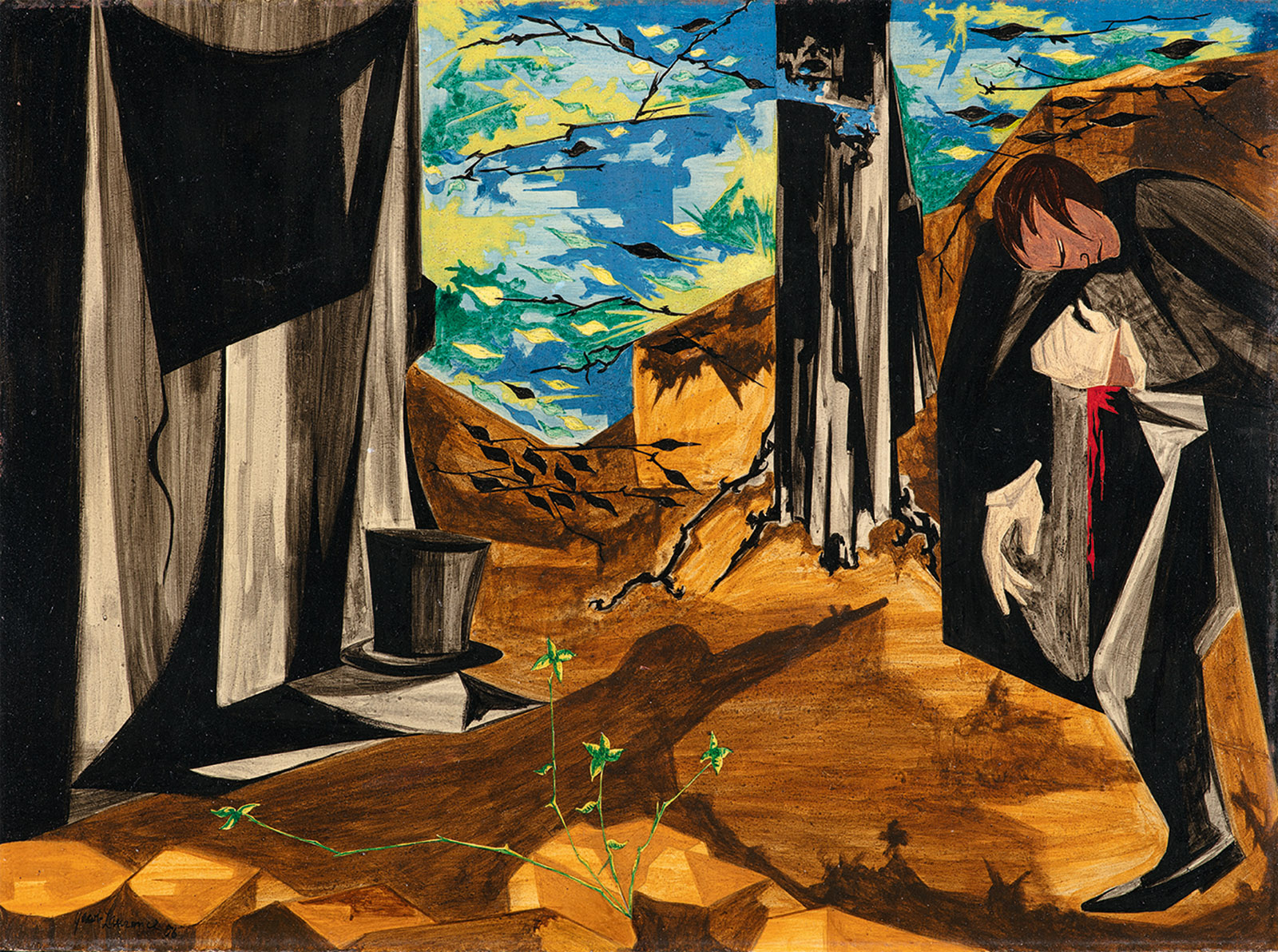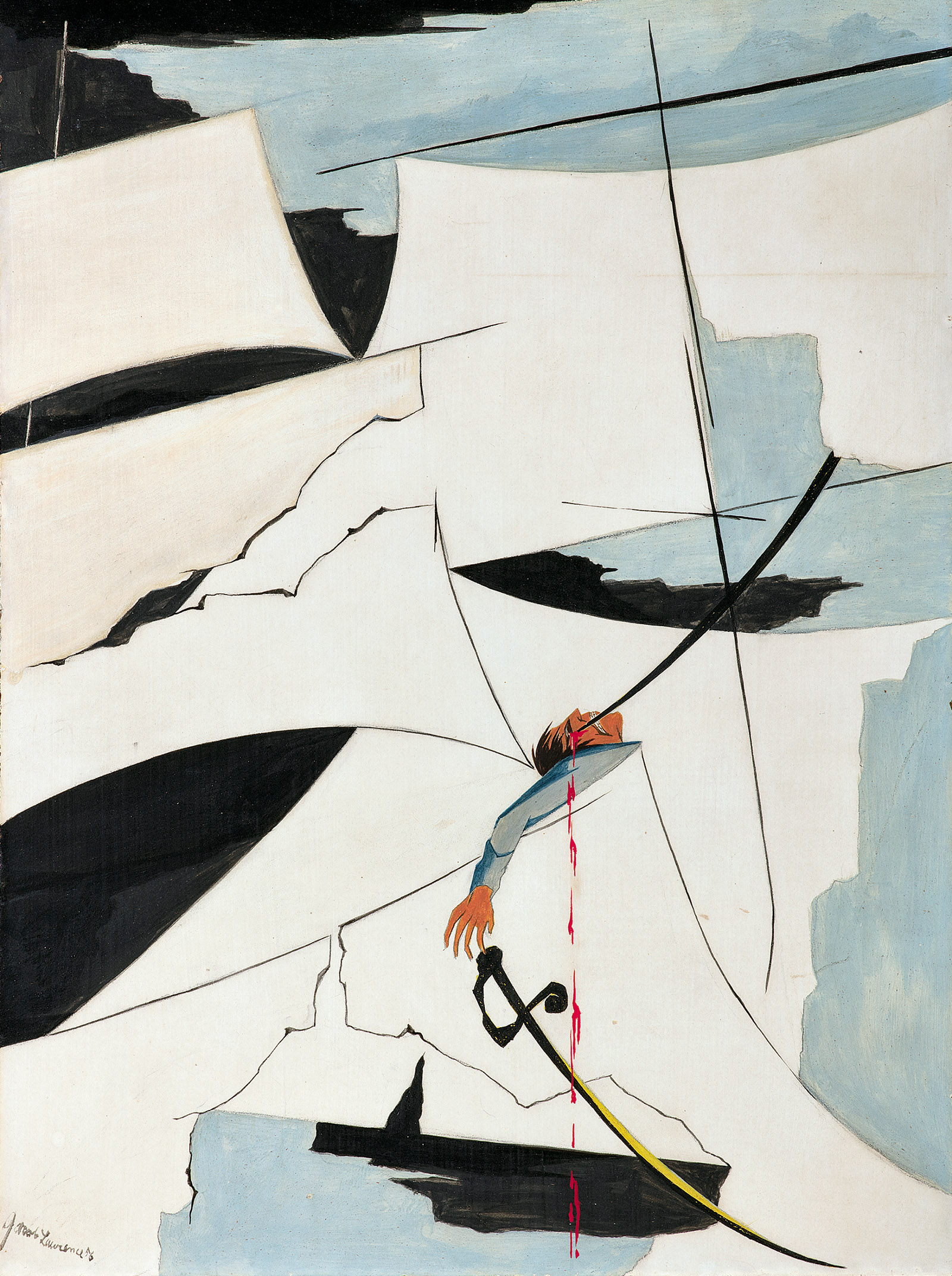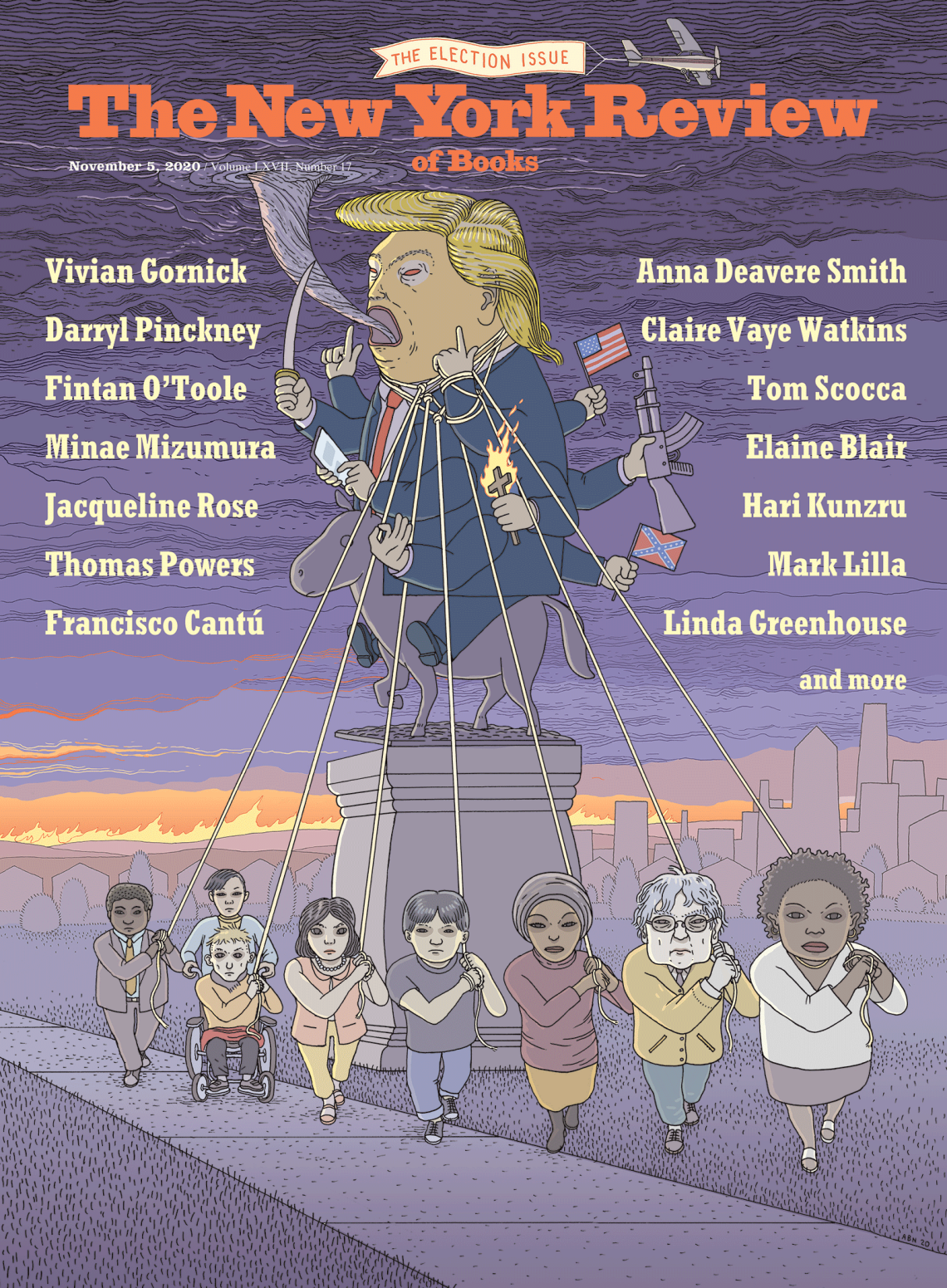As we were waiting on line at the Metropolitan Museum to get into the exhibition “Jacob Lawrence: The American Struggle,” I told my friend that one reason why Lawrence, though long an esteemed name in American art, has a rather modest presence in our museums may derive from his not having made oil paintings. In a long career that stretched from the late 1930s, when he was barely in his twenties, through the late 1990s—he died in 2000, at eighty-two—he primarily used gouache (which is sometimes referred to as poster paint) or tempera.
These water-based paints can be used on paper or on prepared boards—Lawrence used both, but he more often painted on paper—and while works in tempera can get by without being glazed, museums increasingly want them protected by glass. Works on paper are always glazed and they are often matted, too, and the combination of glass and mat can give Lawrence’s pictures a slightly removed, retiring quality, despite the fact that his characteristic subject was the hum and bustle of urban existence, and his pictures are often full of bright, unshaded yellows, greens, reds, blues, purples, and oranges.
Even Lawrence’s best-known work, the 1941 Migration Series, is, due to its very structure, more heard about than seen. Originally titled The Migration of the Negro, the monumental piece details the experiences, moods, and sites that made up the mass twentieth-century exodus of African-Americans from the rural South to cities in the North. Lawrence’s genius was not only to see that the vast story could be the subject of a single artwork but to tell it in a series of separate, self-contained, highly varied small panels. Any viewer taking in its sixty pictures on the walls of a museum—pictures that might show masses of people at a train station, a girl reading in bed, or a corner of an empty wood cabin with the blind drawn—is automatically put on a journey of her or his own to begin with. It did not hurt the fame of the work, which was instantaneous, that its creator was a largely unknown twenty-four-year-old who had dropped out of high school and had little formal art training.
Seeing the work in full, however, takes a certain amount of waiting and luck. Half of it is owned by the Phillips Collection and half belongs to the Museum of Modern Art, which together organized the last, and warmly received, full exhibition in 2015.* Yet when the many panels, which were done in tempera, can be reassembled (in itself demanding a significant amount of wall space), a small but potent element in their favor stems from the way that each has an appropriately plain, simple wood frame, which comes close in to the picture. There is little or no distancing mat, and surely this helps give the pictures their telegraphic force.
The pictures in the current Met show, which are all also tempera on board, form a series, too, and an aspect of their strength comes from the way they have been newly and uniformly placed in crisp white frames that go right up against the images. Sharp-edged and pointy-cornered, they are beautifully of a piece with works that to a large degree feature sharp edges and pointed forms—lethal ones, whether swords, knives, rakes, exaggeratedly long muskets, or fearsome bayonets. But in pictures that recall the taut, angular worlds of Cubism and Expressionism, even objects that are not weapons—the straps of soldiers’ uniforms, creases in cloaks, or the feather headdresses of Native Americans—feel as if they have cutting edges.

Collection of Harvey and Harvey-Ann Ross /PEM/Bob Packert/© The Jacob and Gwendolyn Knight Lawrence Foundation, Seattle/Artists Rights Society (ARS), New York
Jacob Lawrence: I shall hazard much and can possibly gain nothing by the issue of the interview …— Hamilton before his duel with Burr, 1804, 12 x 16 inches, 1956; panel 17 from Struggle: From the History of the American People
Titled by Lawrence Struggle: From the History of the American People and worked on between 1954 and 1956, the twenty-four small pictures on view present moments of many kinds of struggle. (Of the original series, five more have not been found, and one, due to its fragile condition, could not travel.) We see strife on shipboard, in colonial assemblies, in street uprisings, between particular persons, or even in an empty, snowy landscape where elk have been killed by trappers. The tenor of these struggles is physical, literal, and violent. And yet the panels left this viewer believing that Lawrence’s sense of the American past is not that of continual confrontation, fury, and loss, nor that his tone is condemnatory or even reproving.
Advertisement
He seems less outside these moments, judging them from an educated twentieth-century perspective, than a participant within them. He appears too caught up imaginatively in staging his sometimes fevered or bleakly chilly and desolate scenes to pronounce in favor of one side or the other. For this writer, the series is actually a joy and a revelation. It presents a Jacob Lawrence we have not known, a rash, sometimes not altogether comprehensible artist who is different from the somewhat benign creator of pageantlike and often sweet-tempered scenes of urban, and largely African-American, life.
Not seen in its entirety since 1958, the series will at the least be unfamiliar to most viewers. And while the pictures elicit a good deal of commentary in the show’s accompanying catalog, my sense is that, perhaps because they have not had a complete viewing in so long, they have not been sufficiently singled out in the writing on Lawrence. He wanted his story to begin with the run-up to the Revolution and to end with the goodwill tour of the world made by the United States Navy in 1908. His initial aim was to chart the “struggles and contributions of the Negro people.” He went about it the way he approached the Migration panels and his other historical series, which included multipicture accounts of Toussaint L’Ouverture, Harriet Tubman, Frederick Douglass, and John Brown. That is, he first immersed himself, at a library desk, in the histories and pictures he found.
Although they were not the earliest ones he made, he devoted one panel to a slave revolt in 1810 and another to a slave petition from colonial days. As he worked, though, he realized that his subject encompassed more than the “Negro people.” He found himself wanting to form images for, among other subjects, the Declaration of Independence, the Boston Tea Party, the murder of Alexander Hamilton, and the Battle of New Orleans and other aspects of the War of 1812.
He planned to have the projected sixty works completed by 1956, but by then he had done only thirty, and it was thought to show this first half that year. But perhaps because the possibility of a single buyer was at first remote—he very much wanted them to stay together—he did not continue. (They have not stayed together.) Maybe he felt that he had said enough. Much as one would like to know how he would have handled his projected next large topics—the Civil War and industrialism—the pictures in the Met’s show, which was organized by the Peabody Essex Museum in Salem, Massachusetts, feel like a full story in themselves, in part because they do not add up neatly. In many instances, Lawrence’s meanings are elusive.
His showing blood in so many scenes, for instance, is odd. The dripping red can sometimes seem like an unnecessary touch, a mannerism or a decoration. Yet sometimes the blood is shockingly effective. In Massacre in Boston, which is about an uprising against the British in 1770 that resulted in the death of Crispus Attucks, a seaman of African and Indigenous descent, Lawrence shows the dying man’s head as an almost faceless mound emitting a gush of blood.

Collection of Harvey and Harvey-Ann Ross/PEM/Bob Packert/© The Jacob and Gwendolyn Knight Lawrence Foundation, Seattle/Artists Rights Society (ARS), New York
Jacob Lawrence: …If we fail, let us fail like men, and expire together in one common struggle …—Henry Clay, 1813, 16 x 12 inches, 1956; panel 23 from Struggle: From the History of the American People
In a startling image connected to the War of 1812, a sailor caught in shredded sails—only his face and arm are visible—has just been stabbed in the eye, though we don’t see who wields the sword. Lawrence’s image of Hamilton’s duel with Aaron Burr goes straight, as perhaps few other accounts do, for the physical, human consequence of the moment. While Burr is but a shadow on the ground, Hamilton is no Founding Father in a wig but a ruined mere man, about to topple forward, blood streaming from the chest he clutches.
Many of the contributors to the lively catalog for the show rightly look at the political implications of Lawrence’s series. He wasn’t a political artist in the sense that Ben Shahn was; Shahn’s images could be declarations of his positions on issues of the moment. But as the Migration pictures show, Lawrence was keenly aware of the costs of being Black in America. We read that during the years when he was working on the Struggle panels he kept clippings on the Supreme Court’s Brown v. Board of Education decision and the Montgomery bus boycott. Few viewers, moreover, can now look at a picture in the series entitled Trappers, which shows one of the freshly killed elk hanging from a branch, without thinking of lynching.
Advertisement
Speaking in some ways for other writers in the catalog, Randall Griffey, a curator at the Met, notes that “Lawrence’s Struggle series features new and different story lines that expand upon triumphalist national narratives in which heroic white men take center stage.” That Lawrence was saying that the “triumphalist” story lines could stand a dose of reality is made clear, at least on the face of it, by many of the panels. Certainly this is true of the picture whose title is the beginning of the Preamble of the Constitution: We, the people of the United States, in order to form a more perfect Union, establish justice, insure domestic tranquility…—17 September 1787 (see illustration on page 10). The image accompanying these words presents little tranquility. Divided roughly in three, it shows at the top what might be curtains. In the center we see the delegates to the convention, gesticulating in threatening ways and sweating profusely. (It was famously hot at the time.) On the bottom third there is a table on which are simply the many swords left for the moment by the delegates.
This description might make Lawrence’s aim sound satiric. His feuding and buffoonish delegates surely make us feel the hypocrisy in the words of the Preamble, particularly as we know that we are looking at the work of an African-American artist. And yet the verve, ingenuity, and humor with which Lawrence has engineered his image takes a viewer into a different realm than that of satire or indignation. The sheer three-part architecture of the scene—in which the curtains at the top have a stateliness and mystery, the delegates in the middle register are cramped, cross marionettes, and the swords on the bottom third of the picture are like cars parked in a driveway—has a life of its own.
That the colors of the scene are limited to a metallic black, white, gray, and shades of tan (each sword has a little blue line on it, too) enhances the great formal pleasure we take from the work. And in many pictures it is a combination of the wonderfully showy brilliance of Lawrence’s drawing and design and the elliptical, buried, what-am-I-looking-at nature of some of the stories being presented that hit a viewer first and are perhaps what we are left with at the end.
The Tea Party image, for example, which appears to show three figures converging from different sides of the picture—but only one has a fully clear face, and that a mask—reads if anything like a moment in a dance performance when everyone on stage is caught in a jumble of cloaks. The image of Paul Revere’s ride to alert his fellow colonists of the British advance is also, to its benefit, hard at first to decipher and stage set–like in its shallow space. Revere’s black horse, plunging forward in the center, might be our protagonist. Its face is the easiest to make out. But it is smaller than the riled men around it. Which one is Revere is not immediately apparent and, perhaps because of the high boots and smart blue tunics some of the men wear, one might almost be seeing a moment during the civil war that followed the Russian Revolution.
Lawrence adds to the ambiguity that plays over some of these panels with the titles he has given them. Some are oddly flat in themselves and yet take on life when read alongside the images. Tagged to the bristling action of the Revere picture is the mild I alarmed almost every house till I got to Lexington.—Paul Revere.
Another panel is derived from the last sentence of the Declaration of Independence: …we mutually pledge to each other our Lives, our Fortunes, and our sacred Honour—4 July 1776. What relation the accompanying image has to these words, however, is up to the viewer. In this hallucinatory scene, we see a farmer who is largely enveloped in a downpour of spiky hay. A musket, pitchfork, scythe, and rake stand by as, grim-faced, he trudges, bucket in hand, into the hay. Are we looking at Thomas Jefferson’s yeoman hero facing the backbreaking reality of a farmer’s life? Is Lawrence ironically undercutting, if not the words in the Declaration, then Jefferson’s notion of the ideal citizen of the new republic? Our confusion makes the work only more engaging.
When Lawrence eventually decided not to continue with the Struggle series, he also turned away from the fierce emotions and sometimes austere, restrained color of the work. Although his drawing style continued to evolve, and future scenes might be comprised of innumerable tiny, interlocking elements, he left behind, too, the compressed Cubist-and-Expressionist style he created for his Struggle pictures. And while he continued to include now and then figures with white faces in his pictures—his many scenes of carpenters often show Black and white workmen on the same job—he did not again give central positions in his scenes to white people. In many ways, Struggle represented a momentary transformation of his art.
There was, however, some precedent for it. The catalogue raisonnée of Lawrence’s work shows that in the first half of the 1950s, as he drew forms and arranged his pictures with increasing virtuosity, there are paintings here and there that resemble panels in the Struggle series. Many have to do with performers on stage and theater life, which he seems to have been encountering for the first time. In scenes of wildly costumed vaudevillians at the Apollo Theater, for instance, we are given a preview of the Art Deco–like way he makes the jazzy mountain of hay in his panel of the Jeffersonian farmer. But there may have been a stronger factor behind the new formal and emotional bite that Lawrence brought to Struggle.
The early 1950s must have been for him as a painter a time of upheaval, or at least serious questioning. Like some other artists who matured in an earlier time, he had been sheltered from the waves of new, often abstract art coming from Europe. But New York, Lawrence’s city, had become the headquarters of the art world’s latest development, Abstract Expressionism, and the notice taken of it was widespread and insistent. Lawrence’s own approach—he worked representationally, making small pictures on paper or board—might easily have been seen as timorous in relation to the new large abstract canvases of Willem de Kooning, Jackson Pollock, and the others. And how he responded as an artist was bound to have some effect. He was a public figure, and one who carried a certain responsibility on his shoulders. He was already then (and would long continue to be) our foremost African-American painter.
It goes without saying that social and political currents in American life, whether of the past or the present and always risky and rarely auspicious for African-Americans, underlie much of the rawness and power of the Struggle series. Wanting to handle Black “struggles and contributions” was what got Lawrence underway. But something of the drive and willingness to experiment that he brought to the topic may have come from his facing an artistic struggle of his own.
-
*
As it happens, the Modern is currently exhibiting its half, and ten of the panels owned by the Phillips are part of an exhibition at the Whitney Museum of American Art entitled “Vida Americana: Mexican Muralists Remake American Art, 1925–1945.” ↩



